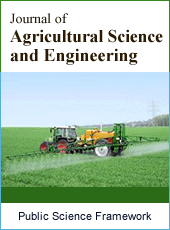Journal of Agricultural Science and Engineering
Articles Information
Journal of Agricultural Science and Engineering, Vol.1, No.3, Aug. 2015, Pub. Date: Jun. 10, 2015
Characterisation of Urban Forest Nurseries: A Case Study of Harare Suburbs in Zimbabwe
Pages: 101-107 Views: 5961 Downloads: 1663
[01]
Silas Mufambi Mudyiwa, Department of Environmental Science, Bindura University of Science Education, Bindura, Zimbabwe.
[02]
Tendayi Nyamugure, Department of Environmental Science, Bindura University of Science Education, Bindura, Zimbabwe.
[03]
Tendai Chitagu, Department of Environmental Science, Bindura University of Science Education, Bindura, Zimbabwe.
[04]
Alfred Kundhlande, Department of Environmental Science, Bindura University of Science Education, Bindura, Zimbabwe.
The study aimed to characterise urban forest nurseries with respect to nine Harare suburbs. Dzivarasekwa, Epworth and Kambuzuma represented high density suburbs, while the medium density was represented by Mabelreign, Waterfalls and Warren Park with Highlands, Chisipiti, and Mandara representing low density suburbs. Stratified random sampling was used to select the study sites. Data collection was carried out using structured and unstructured questionnaires, key informant interviews and observations. Data were analyzed using statistical package for social sciences (SPSS) version 16 through one way Analysis Of Variance (ANOVA). A total of 40 nurseries were identified within the suburbs and the key players in the business were individuals (83 %), non-governmental organisations and public organisations. There was a significant difference between the number of nurseries located in the high and medium density suburbs and those in the low density suburbs. Males dominated the trade (85 %) than women. Most nurseries (65 %) were compliant in terms of registration though few could not meet the registration requirements. Nursery operators were constrained by finance, limited operational space, theft and irrigation water. It is recommended that training be done in nursery management. Associations can also be helpful in gaining recognition by City Council and EMA and this can harness opportunities for thriving business.
Urban Forest, Nursery, Characterization, Constraints
[01]
Arnold, H.F. (1993). Trees in urban design. 2nd edition. Van Norstrand Reinhold, New York.
[02]
Asiedu, J. B. K.; Owusu-Sekyere, J. D.; Taah, K. J.; van der Puije, G. C. and Ocloo, E. (2012). The nursery industry in Ghana: Prospects and challenges. ARPN Journal of Agricultural and Biological Science 7(6):443-453.
[03]
Ajewole, O.I. (2001) Development potentials of urban forestry for sustainable environment conservation of Lagos. M.Phil Thesis. University of Ibadan, Nigeria.
[04]
Akbari, H.; Pomerantz, M. and Taha, H.(2001). Cool surfaces and shade trees to reduce energy use and improve air quality in urban areas. Solar Energy 70 (3): 295-310.
[05]
Babalola, F.D. and Agbeja, B.O.(2006).Commercial private seedling production business in Ibadan, Oyo State: Employment and entrepreneurial opportunities in forestry. Proceedings of 31 Annual Conference of Forestry Association of Nigeria. pp. 468-474.
[06]
Baily, R. (2008). Design of Comparative Experiments, Cambridge University Press, ISB.
[07]
Basweti, C.; Lengkeek, A.; Prytz, L. and Jaenicke, H. (2000). ‘Tree nursery trade in urban and peri- urban areas. A survey in Nairobi and Kiambu Districts, Kenya’, RELMA Working Paper No. 13, Regional Land Management Unit (RELMA), Nairobi, Kenya.
[08]
Becket, K. P.; Freer-Smith, P. and Taylor, G. (2000). Effective tree species for local air-quality management. Journal of Arboriculture 26:12-19.
[09]
Bota, M. G. (2008). Potential of horticultural nurseries in Ghana, A case study in the Ghana North district of the Greater Accra region. B.Sc. Thesis. University of Cape Coast, Ghana. pp. 6-8, 24.
[10]
Diver, S. and Greer, L. (2008). Sustainable small scale nursery production, ATTRA National Sustainable Agriculture Information Service.
[11]
Fakayode, B. S.; Adewumi, M. O.; Rahji, M. A. Y. and Jolaiya, J. A. (2008). Viability and resource use in ornamental plants nursery business in Nigeria. Eur. J. Soc. Sci. 6: 19-28.
[12]
FAO (2009). The potential of urban forestry in developing countries: A concept paper, FAO, Rome
[13]
Joshi, D. R. (1999).Urban Forestry. The Kathmadu Post, India.
[14]
Keith, M. (1990). “African Entrepreneurs Pioneers of Development” Discussion Paper Number 9.
[15]
King, V. J. and Davis, C. (2007). A case study of urban heat island in the Carolinas. Environmental Hazards 7: 353-359.
[16]
Mason, J. (2004). Nursery Management, 2nd Edition. Land Links Press, Australia, pp. 234- 235.
[17]
McPherson, E.G.; Nowak, D.; Heisler, G.; Grimmond, S.; Souch, C.; Grant, R. and Rowntree, R. (1997). Quantifying urban forest structure, function and value: The Chicago urban forest climate project. Urban Ecosystems 1: 49-61.
[18]
Nowak, D.; Crane, D. and Stevens, J. (2006). Air pollution removal by urban trees and shrubs in the United States. Urban Forestry and Urban Greening 4: 115-123.
[19]
Olutayo, O. and Loto, M. A. (1990). Projects analysis and evaluation, Principles and techniques, 4th Edition. Concept Publications, Lagos, Nigeria.
[20]
Poincelot, R. P. (2004). Sustainable horticulture today and tomorrow. Prentice Hall, New Jersey, USA.
[21]
Maco, S.E. and McPherson, E. G. (2003). A practical approach to assessing structure, function and value of street tree population in small communities. Journal of Arboriculture 29: 84-97.
[22]
Mulawarman, A.; Roshetko, J. M.; Susongko, S. M. and Irianto, D. (2003). Tree seed management – seed sources, seed collection and seed handling: A field manual for field workers and farmers. International Centre for Research in Agroforestry (ICRAF) and Winrock International, Bogor, Indonesia.
[23]
Roshetko, J. M.; Mulawarman, A. and Dianarto, A. (2008). Tree seed procurement-diffusion pathways in Wonogiriand Ponorogo, Java. Small Scale 7(3&4):333–352.
[24]
Tonne, H. (1963). Business; Principle organisation, and management, 2nd Edition, The Gregg Division, McGraw-Hill, New York.
[25]
Tyrvainen, L.; Makinen, L. and Schipperijn, J. (2005). Tools for mapping social values for urban woodlands and of other green spaces. Landscape and Urban Planning 79(1): 5-19.

ISSN Print: 2381-6821
ISSN Online: 2381-6848
Current Issue:
Vol. 7, Issue 4, December Submit a Manuscript Join Editorial Board Join Reviewer Team
ISSN Online: 2381-6848
Current Issue:
Vol. 7, Issue 4, December Submit a Manuscript Join Editorial Board Join Reviewer Team
| About This Journal |
| All Issues |
| Open Access |
| Indexing |
| Payment Information |
| Author Guidelines |
| Review Process |
| Publication Ethics |
| Editorial Board |
| Peer Reviewers |


